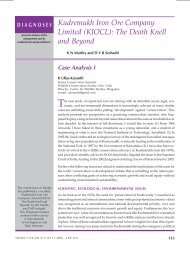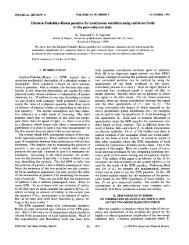Phase Transfer Catalysis - Publications of the IAS Fellows
Phase Transfer Catalysis - Publications of the IAS Fellows
Phase Transfer Catalysis - Publications of the IAS Fellows
You also want an ePaper? Increase the reach of your titles
YUMPU automatically turns print PDFs into web optimized ePapers that Google loves.
catalyst between <strong>the</strong> aqueous and organic phases, assuming<br />
both <strong>the</strong>se phases are present within <strong>the</strong> pores <strong>of</strong> <strong>the</strong> solid<br />
support.<br />
Various o<strong>the</strong>r mechanisms have also been proposed to explain<br />
<strong>the</strong> complex interaction between <strong>the</strong> catalyst and <strong>the</strong><br />
two liquid phases, and <strong>the</strong> transport <strong>of</strong> compounds within <strong>the</strong><br />
solid support. Hradil et al. (1987) demonstrated that <strong>the</strong><br />
transfer <strong>of</strong> reactive species between phases inside <strong>the</strong> catalyst<br />
particle is guided by conformational changes in <strong>the</strong> polymer<br />
chain which cause oscillations <strong>of</strong> <strong>the</strong> immobilized cation between<br />
<strong>the</strong> two phases, both <strong>of</strong> which are present within <strong>the</strong><br />
polymer matrix. Rate limiting steps in a triphase catalytic system<br />
are believed to be related to <strong>the</strong> frequency <strong>of</strong> oscillation<br />
<strong>of</strong> reactive sites within <strong>the</strong> solid support. Thus, PT catalysts<br />
supported on macroporous polymers or highly cross-linked<br />
beads, which do not swell in solution, are found to be ineffective<br />
catalysts due to <strong>the</strong> severe restrictions within <strong>the</strong> support<br />
not only to diffusion <strong>of</strong> species within <strong>the</strong> pores <strong>of</strong> <strong>the</strong> solid<br />
but also to <strong>the</strong> oscillation <strong>of</strong> <strong>the</strong> reactive groups between <strong>the</strong><br />
phases. The mobility <strong>of</strong> <strong>the</strong> cation-bearing chain thus determines<br />
<strong>the</strong> effectiveness <strong>of</strong> <strong>the</strong> immobilized PT catalyst,<br />
whereas <strong>the</strong> hydrophilic-lipophilic balance <strong>of</strong> <strong>the</strong> support<br />
structure determines <strong>the</strong> distribution <strong>of</strong> <strong>the</strong> two phases within<br />
<strong>the</strong> solid support pores (Ruckenstein and Park, 1988, Ruckenstein<br />
and Hong, 1992). The catalytic functional groups<br />
within <strong>the</strong> polymer matrix determine <strong>the</strong> microenvironment<br />
<strong>of</strong> <strong>the</strong> support structure, which in turn affects <strong>the</strong> overall reactivity.<br />
The case <strong>of</strong> liquid-solid-solid systems is even more complicated<br />
since <strong>the</strong> solid nucleophilic reagent has to come in contact<br />
with <strong>the</strong> solid catalyst particles for ion exchange to occur<br />
(plausibly involving a solid-solid reaction), followed by contact<br />
<strong>of</strong> <strong>the</strong> solid catalyst particles with <strong>the</strong> liquid for <strong>the</strong> main<br />
organic reaction (Figure 14). MacKenzie and Sherrington<br />
(1981) conducted a detailed mechanistic study <strong>of</strong> a liquidsolid-solid<br />
reaction and concluded for <strong>the</strong> system studied that<br />
transfer <strong>of</strong> <strong>the</strong> nucleophilic reagent to <strong>the</strong> catalyst surface<br />
occurred by direct contact between <strong>the</strong> two insoluble solids.<br />
Addition <strong>of</strong> traces <strong>of</strong> water increased <strong>the</strong> rate <strong>of</strong> reaction, as<br />
in SLPTC systems, possibly by increasing <strong>the</strong> rate <strong>of</strong> transfer<br />
<strong>of</strong> <strong>the</strong> inorganic reagent to <strong>the</strong> catalyst. It has also been hy-<br />
Immobilized phase transfer catalyst (Q+X-)<br />
l Solid inorganic reagent (M+Y-)<br />
0 Organic reagent droplets (RY)<br />
Figure 14. Plausible mechanism for liquid-solid-solid<br />
triphase catalysis.<br />
Adapted from Desikan and Doraiswamy (1995).<br />
po<strong>the</strong>sized (Yanagida et al., 1979) that reaction in a liquidsolid-solid<br />
system is possible due to dissolution <strong>of</strong> <strong>the</strong> solid<br />
nucleophile in <strong>the</strong> organic reagent (analogous to homogeneous<br />
solubilization in SLPTC), followed by transport <strong>of</strong> <strong>the</strong><br />
dissolved species in <strong>the</strong> organic liquid into <strong>the</strong> solid, Kondo<br />
et al. (1994) also suggest direct solid-solid interaction leading<br />
to <strong>the</strong> formation <strong>of</strong> a complex between <strong>the</strong> solid nucleophilic<br />
reagent and <strong>the</strong> solid polymeric support by <strong>the</strong> cooperative<br />
coordination <strong>of</strong> active sites in <strong>the</strong> polymer and <strong>the</strong> alkali metal<br />
ion <strong>of</strong> <strong>the</strong> reagent. On <strong>the</strong> o<strong>the</strong>r hand, a simple extraction<br />
mechanism similar to classical PTC has been suggested by<br />
Arrad and Sasson (1991) with reaction rates being controlled<br />
by ei<strong>the</strong>r mass transfer <strong>of</strong> <strong>the</strong> inorganic reagent by small<br />
amounts <strong>of</strong> water or <strong>the</strong> organic phase chemical reaction. Ion<br />
exchange is believed to proceed by transportation <strong>of</strong> nucleophile<br />
into <strong>the</strong> solid catalyst pores via dissolution in <strong>the</strong> traces<br />
<strong>of</strong> water which are always present and form a fourth saturated<br />
phase in <strong>the</strong> system. In <strong>the</strong> absence <strong>of</strong> water, direct<br />
interaction <strong>of</strong> <strong>the</strong> nucleophile with <strong>the</strong> surface <strong>of</strong> catalyst can<br />
lead to small amounts <strong>of</strong> reaction, although traces <strong>of</strong> water<br />
help increase <strong>the</strong> mass transfer <strong>of</strong> <strong>the</strong> nucleophile. Similarly,<br />
Arrad and Sasson (1990) also reported that <strong>the</strong> ion-exchange<br />
reaction takes place on <strong>the</strong> surface <strong>of</strong> <strong>the</strong> silica support which<br />
was impregnated with onium salts. Thus, <strong>the</strong> mechanism <strong>of</strong><br />
reaction in liquid-solid-solid systems is far from clear and<br />
needs considerable fur<strong>the</strong>r investigation. An interesting version<br />
<strong>of</strong> liquid-solid-solid PTC is reported by Nishikubo et al.<br />
(1983) and Iizawa et al. (1987) who conducted <strong>the</strong> reaction <strong>of</strong><br />
insoluble polystyrene with a solid nucleophilic reagent mediated<br />
through an organic solvent which contained a PT catalyst.<br />
This is an example <strong>of</strong> a solid-solid reaction that is made<br />
possible by adding a third liquid phase, whereby finite<br />
amounts <strong>of</strong> <strong>the</strong> nucleophilic reagent dissolving in <strong>the</strong> organic<br />
phase are picked up by <strong>the</strong> quaternary ammonium salt (PT<br />
catalyst) present in <strong>the</strong> organic phase and transported to <strong>the</strong><br />
relatively polar solid polymer phase, where it undergoes <strong>the</strong><br />
substitution reaction.<br />
Kinetics and Modeling <strong>of</strong> Triphase <strong>Catalysis</strong>. So far only <strong>the</strong><br />
qualitative features <strong>of</strong> <strong>the</strong> factors affecting triphase catalysis<br />
were discussed. Modeling <strong>the</strong> complex dynamics <strong>of</strong> diffusion<br />
and reaction in a triphase system is difficult without a better<br />
understanding <strong>of</strong> <strong>the</strong> mechanism involved. Besides, <strong>the</strong> effects<br />
<strong>of</strong> a number <strong>of</strong> variables that influence <strong>the</strong> performance<br />
<strong>of</strong> a triphase catalyst have not been quantitatively understood.<br />
Thus, it is not surprising that only a few articles have<br />
reported detailed kinetic and modeling studies on TPC. These<br />
articles all deal with liquid-liquid-solid systems and to <strong>the</strong> best<br />
<strong>of</strong> our knowledge, no studies dealing with <strong>the</strong> modeling <strong>of</strong><br />
liquid-solid-solid systems have been reported so far.<br />
Marconi and Ford (1983) were among <strong>the</strong> first to model<br />
triphase catalysis based on standard equations developed for<br />
porous catalysts in heterogeneous catalysis. They derived an<br />
expression for <strong>the</strong> effectiveness factor to describe <strong>the</strong> effects<br />
<strong>of</strong> mass-transfer resistances outside and within <strong>the</strong> supported<br />
catalyst particles. The model considers <strong>the</strong> mass transfer <strong>of</strong><br />
<strong>the</strong> organic substrate from <strong>the</strong> organic bulk to <strong>the</strong> surface <strong>of</strong><br />
<strong>the</strong> catalyst and subsequent diffusion <strong>of</strong> <strong>the</strong> organic substrate<br />
into <strong>the</strong> pores <strong>of</strong> <strong>the</strong> catalyst, followed by <strong>the</strong> main organic<br />
reaction inside <strong>the</strong> catalyst. With <strong>the</strong>se assumptions, equations<br />
from traditional heterogeneous catalysis can be adapted<br />
to TPC, to give at steady state<br />
AIChE Journal March 1998 Vol. 44, No. 3 631
















